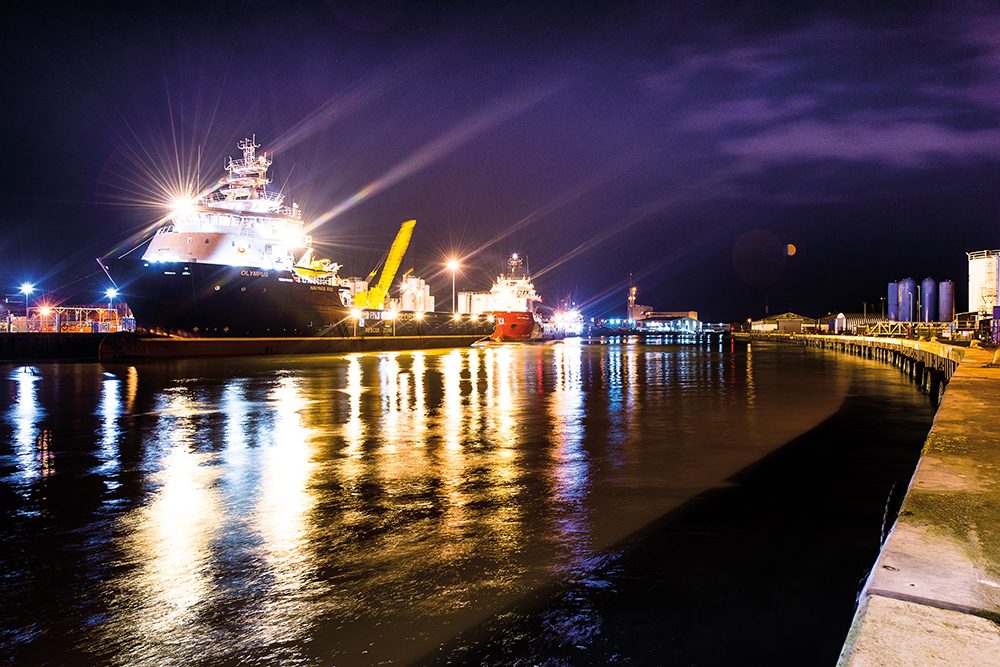One of the UK’s most easterly ports, Great Yarmouth has established itself as a leading offshore energy port, with more than 50-years’ experience supporting the sector.
In this issue, we speak to Ranjit Singh Nagra, Sales Manager, about the port’s operations through time and tide, 24 hours a day, 365 days a year and learn more about their role in the emerging offshore renewable energy industry.
Once an important fishing port, famous for herrings, today you’ll find a modern, multi-purpose port which integrates the new, deep-water outer harbour with a well-established river port.
What you may not know is that Peel Ports Great Yarmouth offers the shortest North Sea crossing to the northern continental European ports. Meaning supplies are handled for a variety of industries including the offshore, renewable, decommissioning, agri-bulk, aggregates and automotive markets. Providing deep water berths and a 24-hour piloting service, unlike some other ports, its operations are rarely restricted by tidal times.
In 2007 under its previous owners, Peel Ports Great Yarmouth underwent a huge improvement programme, which saw the outer harbour constructed enabling larger vessels to berth at the port. Now it is one of a small number of UK ports capable of loading vessels over 13,000 tonnes.
To date, the largest vessel to enter the harbour has been the GLOVIS SPLENDOR, a vehicle carrier which unloaded a staggering cargo of 3,300 cars destined for dealerships across the UK – but this record may soon be superseded.
Acquired by Peel Ports in 2015, Great Yarmouth now benefits from the expertise of one of the largest groups to manage ports across the UK and Ireland. Their portfolio includes Liverpool, Dublin, Clydeport and London Medway – to name but a few.
Customers benefit from infrastructure, facilities and services to which they may not otherwise have access. Whilst the well-established logistics and supply chain enables cargo to be transported across the UK, Ireland and beyond, quickly and efficiently. “We work closely with other businesses,” Ranjit explains, “so our customers benefit from a comprehensive and responsive supply chain.”
Under Peel Ports’ ownership, investment in the port has continued apace. Recently, over £12 million has been invested in upgrades to the outer harbour, including creating a 130,000 square meter supply base for offshore wind farm construction support.
The investment has also included new cranes in-river and in the outer harbour, allowing greater amounts of cargo to be transferred in a shorter amount of time, and providing a more productive and flexible service for customers.
Since our last issue, the latest investments have included a new Pilot boat and a new crane with an 84 t lifting capacity. The LHM280 crane – which was purchased from Liebherr – is capable of turning over up to 35 Cycles per Hour, providing increased cargo handling capabilities. Thereby allowing for mobilisation and demobilisation processes to be shortened.
Already the port’s operational efficiency and capacity for unitised, non-unitised and bulk cargoes for all commodities has been substantially increased – but further improvements are afoot.
The East of England, as we’ve learnt, provides the perfect mix of physical and locational characteristics such as shallow waters, consistent wind speeds and proximity to key UK and European port locations, creating a favourable environment for offshore wind production.
Whilst Peel Ports Great Yarmouth itself, sits in a strategic position making it the ideal base for reaching the southern North Sea oil and gas fields, plus existing and planned offshore wind farm developments off the east coast. Located on a 40 acre site, the port also offers much scope for development.
This is all the more significant when you realise that nearly 4GW of offshore wind power is operational off the East of England, accounting for 52% of the UK’s current 7.5GW installed capacity – and this is set to grow substantially over the coming years.
So it’s no surprise that more investment is planned at Peel Ports Great Yarmouth, as part of the East of England’s role in the government-industry Offshore Wind Sector Deal.
Through this additional investment, offshore wind farm development will be supported through preassembly, construction, installation, operations and management.
“We are planning further significant expansion at the outer harbour to create a centre of excellence for operations and management, including 350m of extra berthing space and about 100,000sqm of additional land,” explains Ranjit.
“These facilities will include an extended quayside space with deep water access, a new training centre, and space to accommodate at least one major manufacturer of wind turbine components.
“With our involvement and other businesses across the region, the cumulative capacity in operations and development off the East of England is 14.5GW, enough to meet approximately half of the Sector Deal ambition for 2030.”
Hand in hand with this development comes the opportunity to create more jobs, which is good for the community and good for the regional economy too.
Peel Ports themselves, are set to recruit more people in Great Yarmouth. Whilst the next generation of engineers is being encouraged with their apprenticeship scheme.
In talking to Ranjit, it is apparent that their skilled team is integral to the port’s success. “We have an agile and supportive team here, who are experienced in everything from engineering to operations.
“They turn their skills to a multitude of scenarios and are well versed in handling a wide range of commodities through the port, providing clients with all the technical information and support they need.
“Solution driven, they always find a way to get the job done for our customers, facilitating the transportation of cargo between our ports, across the UK, Europe and further afield.”
Peel Ports Great Yarmouth it is clear is on the right track, setting sail towards a bright future.
Ranjit Singh Nagra – Sales Manager, Peel Ports Great Yarmouth





